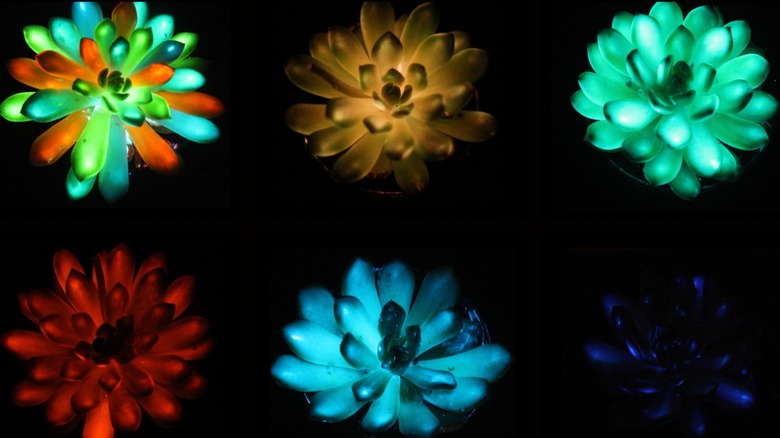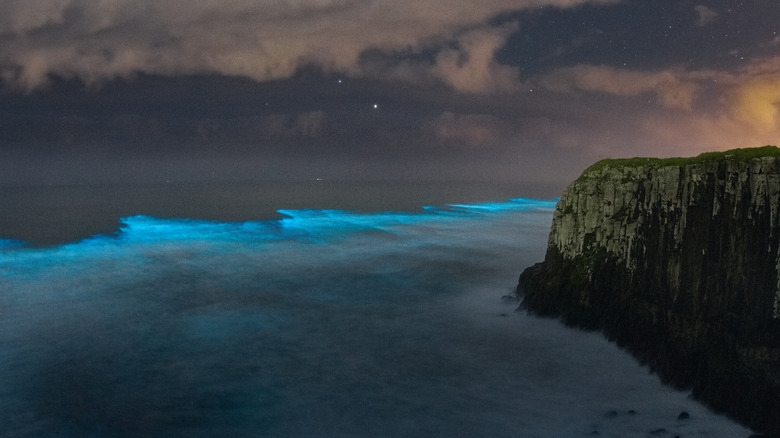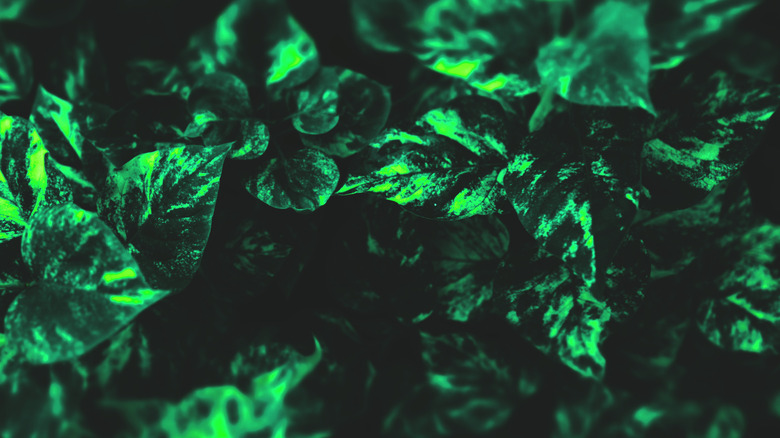Researchers Create Avatar-Inspired Plants (And The Science Behind It Will Blow Your Mind)
James Cameron's "Avatar" movies are some of the biggest blockbusters of all time, with stunning visuals that were truly eye-popping for cinema audiences. Not only did the story focus on the lives of the Na'vi, 10-foot-tall humanoids with blue skin, but it unfolded on the planet Pandora, the fantastical landscape of which is populated by striking plant life, including enormous trees that emit a beautiful ethereal glow. And for those moviegoers who found themselves wishing they could visit Pandora, there is some good news. Scientists have brought us one step closer to living in such a landscape by inventing beautiful new organic plants that can actually glow in the dark — raising the prospect of a new way of lighting the world around us.
Publishing their findings in the scientific journal "Matter" in August 2025, a team of researchers from South China Agricultural University in Guangzhou, China, claim to have masterminded "sunlight-powered multicolor and uniform luminescence in material-engineered living plants," which lead-researcher Shuting Liu claimed has allowed them to create "essentially, a light charged, living plant lamp" (per CNN).
Bioluminescence in nature
It may sound like the stuff of fantasy, but glowing organic material already exists in various forms in the natural world. In nature, such a phenomenon is known as bioluminescence, which researchers have long been interested in engineering in a laboratory setting, which would be the first step to developing a new form of light technology.
Among the animal life that exhibits bioluminescence are fireflies, actually a species of beetle which generates light in its abdomen by combining the chemical luciferin with luciferases enzymes and oxygen, with the light being used to attract a mate. Bioluminescence is common in deep sea environments, where it is incredibly dark, with species such as the angler fish using light to catch prey. It is estimated that around 75% of deep sea creatures emit some form of bioluminescence. But you don't have to take a trip in a submarine to experience such a phenomenon: phytoplankton, small bioluminescent sea creatures that emit light as a form of protection, can be observed in the right circumstances — usually in warm, still waters — on beaches across the planet. Bioluminescence also occurs naturally in fungi and bacterial life.
The science of engineering bioluminescent plants
Among plant species, however, there is no known naturally-occurring bioluminescence, though scientists have been successful over the years in replicating the effect found elsewhere in nature in certain genetically-engineered species. The startup company Light Bio recently debuted the Firefly Petunia, which employs glow-in-the-dark mushroom DNA to give the plant the same luminosity. However, though the effect is indeed enchanting, Firefly Petunia owners note that the light is very dim and not bright enough for the practical applications that scientists in general are hoping for.
The recently developed Fluorescent Phalaenopsis Orchid, which was made public in 2024, was created by a team of scientists at Japan's Chiba University and presented at that year's World Orchid Show in Tokyo. In this case, the plant was given a fluorescent protein gene taken from Cyridius poppei plankton. The orchid is capable of emitting a yellow-green fluorescence, but only does so under a black light. Gene editing has also been the preferred method of researchers creating their own luminous plants at the Massachusetts Institute of Technology.
But South China Agricultural University has gone in another direction. Their experiments have involved injecting the succulent Echeveria "Mebina" with nanoparticles of strontium aluminate, the glow-in-the-dark material familiar from its use in children's toys. Doing so has allowed them to create plants in a range of colors — the researchers have revealed plants glowing red, blue, and green — with the material absorbing light and emitting it for hours after the light source has gone, making it essentially rechargeable.
Practical applications of glow-in-the-dark plants
The South China Agricultural University researchers responsible for these new bioluminescent succulents have had to overcome major roadblocks to get their idea to come to fruition. Chief among them was the fact that strontium aluminate decomposes naturally after being in the plant, which then leads to cell damage and the plant's death. However, they responded to the problem by engineering a coating for the material that blocks it from seeping into the plant's cells upon decomposition. While the plants only glow for about two hours after being charged by the sun or LED light, they can be recharged to emit light for 25 days after the material is introduced to them, though they do dim over time.
The researchers involved are understandably excited about the prospect of rolling out the production of the new "Avatar" plants, which could mean the creation of plants that offer a practical light source. A wall of 56 of the plants displayed by researchers was reportedly able to provide enough light to read text and images by, and to illuminate the face of a person standing four inches away.
The technology isn't quite as developed as they would like, but with research ongoing, those behind the project see a bright future for their plants. Shuting Liu explained (via CNN) that the plants "are still far from providing functional illumination, as their luminescence intensity remains too weak for practical lighting applications. Additionally, the safety assessment of afterglow particles for both plants and animals is still ongoing," adding, "if we can significantly enhance the brightness and extend the duration of luminescence — and once safety is conclusively demonstrated — we could envision gardens or public spaces being softly illuminated at night by glowing plants."


